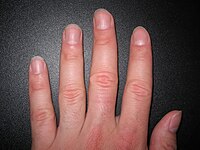
Photo from wikipedia
Claw horn disruption lesion (CHDL) is the collective term used to describe non-infectious foot lesions such as sole ulcers (SU), sole hemorrhage (SH), and white line disease (WLD) that commonly… Click to show full abstract
Claw horn disruption lesion (CHDL) is the collective term used to describe non-infectious foot lesions such as sole ulcers (SU), sole hemorrhage (SH), and white line disease (WLD) that commonly affect dairy cattle. The potential role of the bovine digital cushion, an anatomical structure located under the pedal bone and composed mostly of adipose and connective tissue, in the aetiopathogenesis of CHDL has recently been the subject of several studies. The aim of this prospective cohort study is to identify risk factors associated with the development of CHDL and to add further evidence regarding the role of the digital cushion. In order to achieve that we collected data from 500 lactations; 455 dairy cows from 3 farms were enrolled in this study. Data were collected from each animal on three occasions: 3–4 weeks before expected calving date, 1 week post calving, and 8–10 weeks post-calving. At each occasion, sole soft tissue thickness (the combined depth of the digital cushion and corium, SSTT) was measured using B-mode ultrasonography. At 8–10 weeks post-calving foot trimming was undertaken and the presence of CHDLs was recorded. Univariable analysis was undertaken between variables of interest, before multivariable regression models were constructed. Mixed effects multivariable linear regression models were created to describe the changes in SSTT and associations with various explanatory variables. Multivariable logistic regression models with the presence of SU, SH, or WLD as an outcome were also built. SSTT was shown to decrease from calving to early lactation (EL). Primiparous animals were found to have smaller SSTT, than multiparous animals. Animals with greater BCS had greater SSTT. Cows with a SU in early lactation had lower SSTT both at pre-calving and calving inspections comparing to cows without a SU. Cows that developed mastitis within 30 days of calving had approximately four times higher odds of developing SU compared to cows that did not develop mastitis. Our study advances our understanding of animal level risk factors associated with the development of CHDL and highlights the importance of the periparturient period.
Journal Title: Frontiers in Veterinary Science
Year Published: 2020
Link to full text (if available)
Share on Social Media: Sign Up to like & get
recommendations!